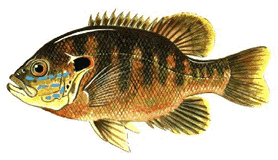Back to Previous Page
GREEN SUNFISH

At-a-Glance
- Scientific Name: Lepomis cyanellus
- Found in Illinois: Statewide
- State Average: 4.5"
- State Record: 2 lbs/1 oz (1981)
- Best Lures: worms, grasshoppers
- Best Lakes (based on average size): Busse Lake, Diamond Lake, Shabbona
This bigmouthed sunfish strikes viciously at practically any natural or artificial bait thrown his way. Ounce for ounce, this gamey little fighter, if he could ever attain the size of one or more pounds, would probably put most sport fishes to shame with his bulldog fighting tactics.
Green sunfish are easily caught on most types of bait and smaller lures such as jigs. Cast lures or bait near structure (e.g., brush, rocks, woody debris, etc.) in the upper to middle water column.
Habitat:
Green sunfish are found throughout Illinois in nearly every creek, river, and lake, including farm ponds. Due to their higher tolerance to poor water quality, they can be found in very muddy and eutrophic systems. As with most sunfish species, greens prefer to seek refuge in and around structure, including rocks, brush, vegetation, and logs.
Feeding and Habits:
Green sunfish feed on a wide variety of food items due to their larger mouth. Their diet mainly relies on aquatic insects, but will also include small fish and crayfish.
Reproduction:
Green sunfish share similar reproductive habits with bluegill, nesting in colonies in shallow water near the shoreline — often times in the same location. The major reproductive activity for green sunfish occurs during the latter part of May or first part of June, but some spawning may occur throughout the summer. Prior to mating, the more highly colored males build their nests in colonies along the shoreline in water one to three feet in depth. After considerable territorial fighting, the male successfully directs one or more females to his nest. Spawning occurs with the simultaneous emission of eggs and sperm. Several thousand eggs are deposited by each female into the nest. As is typical of the sunfish family, the male assumes the duties of protecting the nest and fanning the eggs to keep them oxygenated and free of silt.



